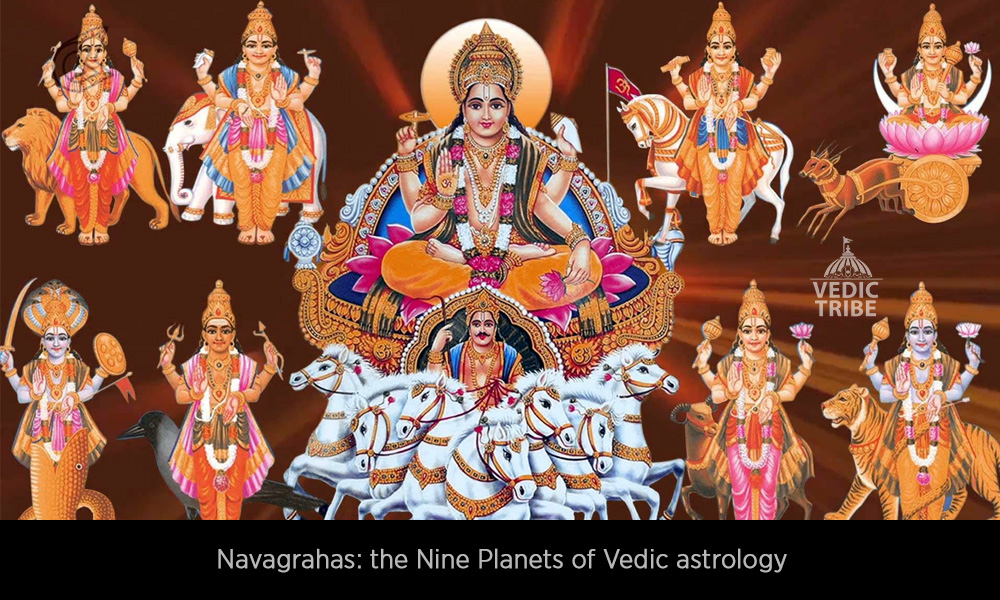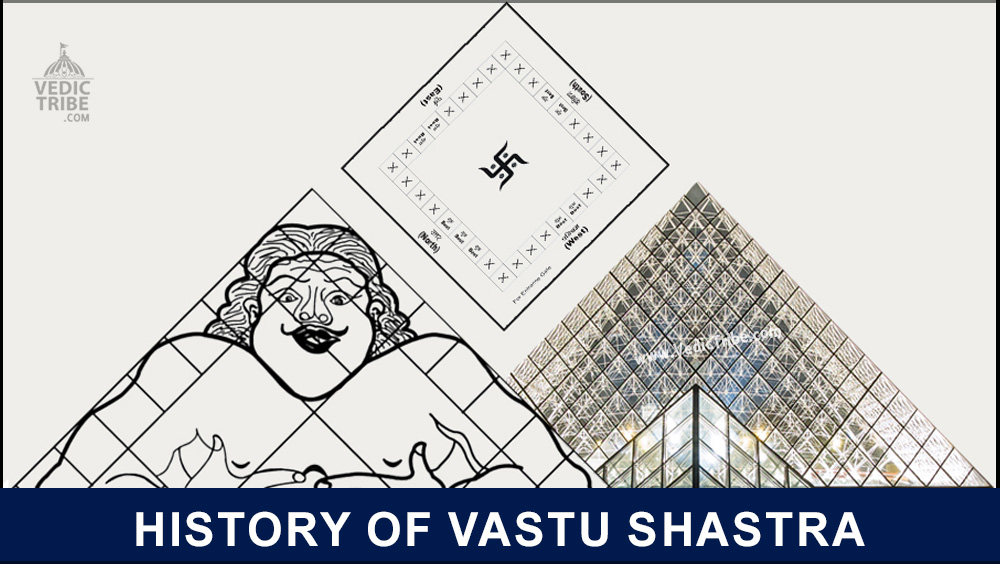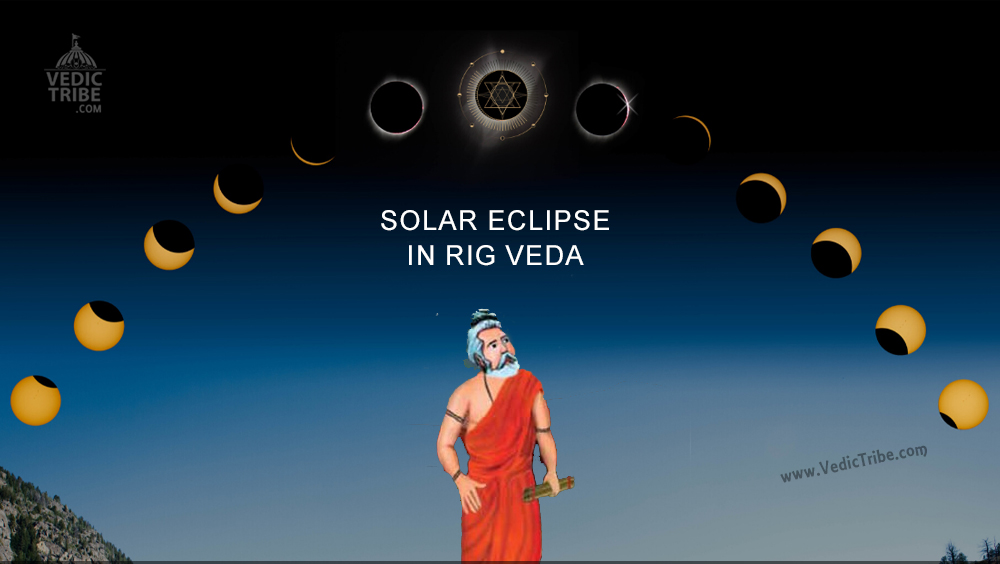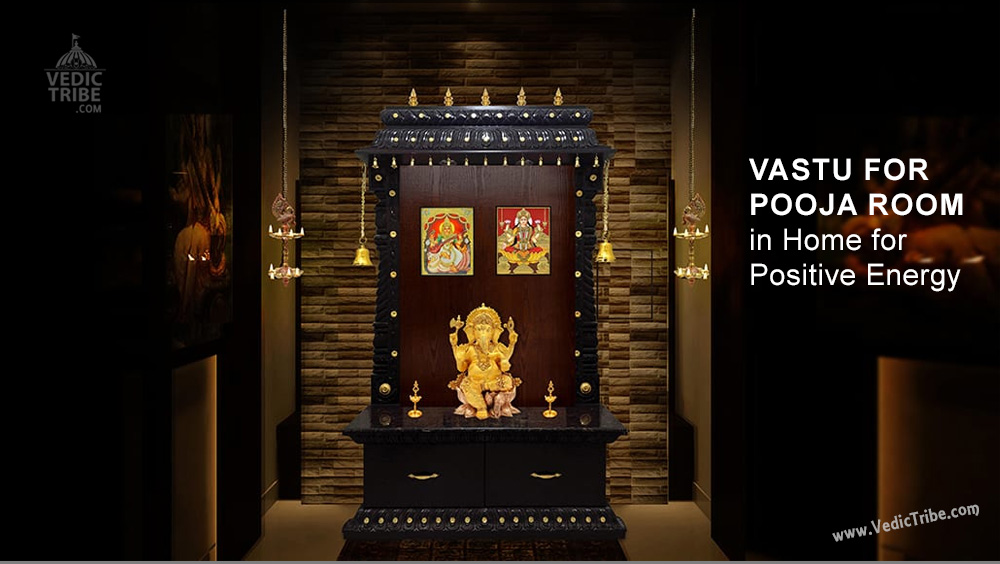The practice of Vedic astrology, the system of predicting one’s destiny based on the position of the stars and planets, is as timeless as ancient India.
Originating from the Vedas, a collection of sacred Hindu texts, astrology is still prevalent today, so much so that many Hindus will consult with an astrologer before pursuing any major life endeavor, or when they are experiencing particular hardship.
Besides explaining to people what their general nature and destiny encompasses, a Vedic astrologer will often recommend certain remedial measures that can be enacted to help minimize the effects of foreseen negative circumstances. Amongst other things, these measures usually center around performing puja (worship) to a particular planet.
To get a grasp on why Hindus in the 21st century would actually take seriously the idea of worshipping planets to better their life’s situation, it’s essential to understand how the planets are viewed from a Vedic and astrological perspective.
Firstly, it’s important to note nothing in Vedic astrology is actually referred to as a “planet.”
Astrologers instead use the sanskrit term graha, which literally translates as “that which grabs or holds.”

In his book “Astrology of the Seers,” David Frawley writes:
“Each planet in its orbit gathers in and gives out forces, and thereby transmits a particular wavelength of energy necessary for maintaining the order of the solar system. The planets are perpetually flashing forth with energy in different patterns and cycles of transmission weaving the web of life and creation.”
This energy, as described by Frawley, determines the quality of the time phases in which we live. In other words, the planets affect the condition of each particular chapter of our lives. Planets are described therefore as grahas, because of the way they take hold of and influence life.
Vedic astrology pays attention to nine grahas, which are collectively referred to as the navagrahas, with nava meaning nine. They include the sun (Surya), moon (Chandra), Mars (Mangala), Mercury (Budha), Jupiter (Brihaspati), Venus (Shukra), Saturn (Shani), Rahu (north node of the moon), and Ketu (south node of the moon).
Rahu and Ketu are subtle grahas with no actual mass. They represent the two points in space where the orbital path of the sun and moon intersect. Because eclipses block light and occur in connection to the nodes, Rahu and Ketu are often called “shadow planets,” and are generally indicators of negative influences.
According to the Vedas, each graha represents a particular aspect of life, and each is under the jurisdiction of a particular deity. Just as Jeff Bezos is the personality behind Amazon and Elon Musk is the personality behind Tesla — companies which are distinct for having certain qualities and providing certain services, there are personalities behind grahas, which are distinct for delivering and maintaining the different conditions of an individual’s life.
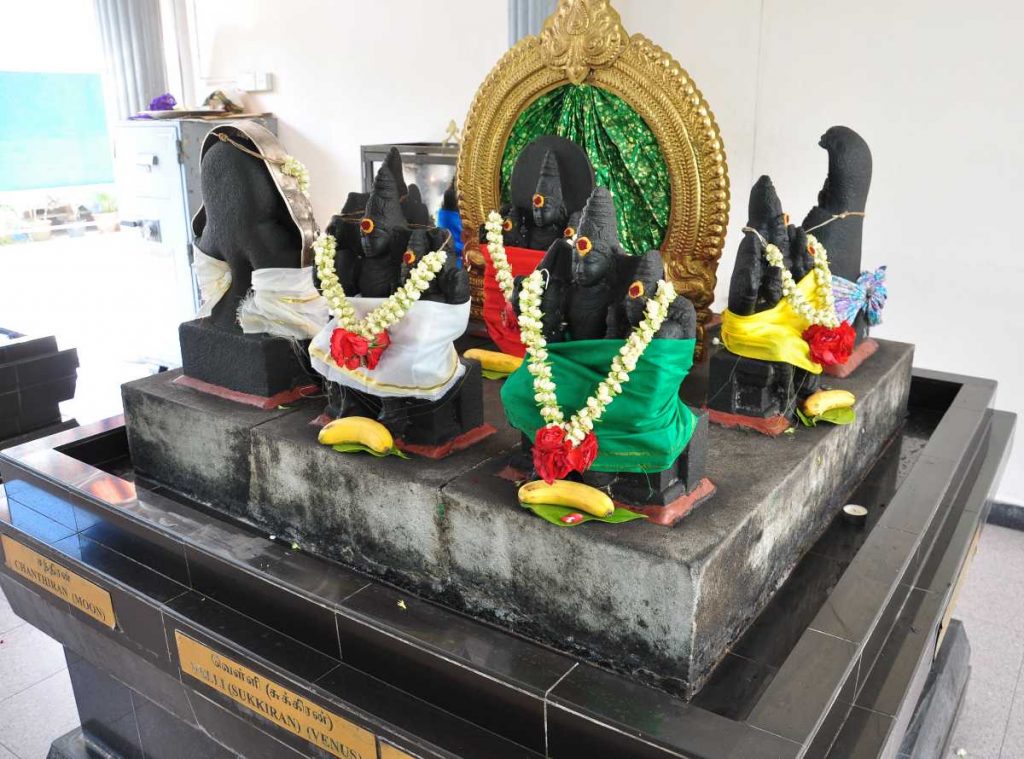
Life is ultimately meant for spiritual growth. This growth is enabled by karma, the Hindu concept that every thought and action has a corresponding reaction.
Through karma, good acts uplift one’s consciousness to a more selfless plane of living, while bad acts lower the consciousness to a more self-centered plane. Thus, a person experiences lessons in empathy, and is encouraged to live a life of love and gratitude.
People experience karma over a series of lives in a cycle of birth and death known as samsara, in which they are faced with the lessons they must go through in order to grow.
The deities of the navagrahas are in charge of delivering us these lessons, and therefore play an integral role in helping to facilitate our spiritual development.
Venus, for example, is ruled by a deity called Shukra. Including other things, Venus generally represents the wife in a man’s horoscope. Hence, a poorly placed Venus can often indicate marital problems, or even issues in finding a wife.
Perhaps in a past life, a man took his wife and marriage for granted and as a result, is now having a hard time finding a partner. Seeing a poorly placed Venus, the astrologer might recommend the man perform some sort of puja to appease Shukra into minimizing the bad marital karma.
As stated before, life is ultimately meant for one’s spiritual evolution. Experiencing troubles in finding a partner is not Divinity’s way of enacting revenge. It’s to help a person better appreciate the value of such a partner.
A person, therefore, should not view hardships merely as hurdles on the path of hedonistic pursuit. Life’s obstacles should be seen as opportunities for gaining spiritual maturity, and the deities of grahas should be approached as revered teachers of these lessons.
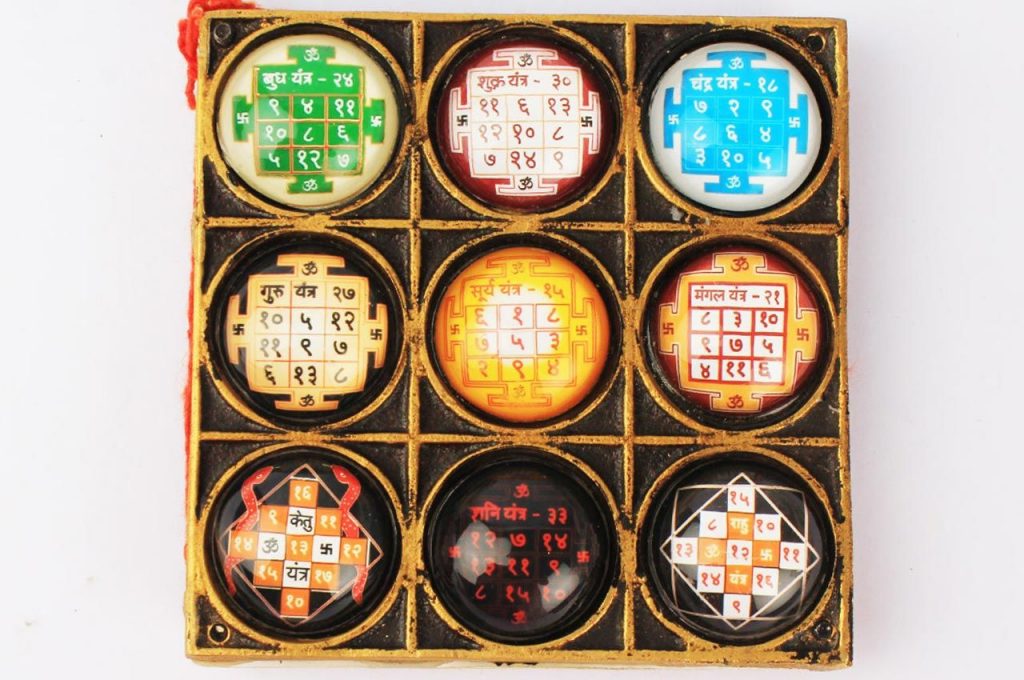
The influence of the stars, planets and other elements of the cosmos on our existence is undeniable. Planetary positions and conjunctions at a given point in time can create, support and disrupt harmony in nature. While the energies exerted by these forces have a visible and marked impact on life on our planet, these energies also have an intangible, deeper connect with our everyday lives – our joys and sorrows.
The word graha means ‘to grasp’. Planets are believed to grasp and exert karmic forces that affect our lives, both in a positive and negative manner. A graha can be auspicious or inauspicious for an individual or a group of people – even nations – based on its planetary position at a given point of time. The subtle energies conveyed by the grahas affect the physical and mental faculties of living beings, thus impacting our karmas and the consequences thereof.
Jyotisha-shastram, an important branch of Vedic studies – also known as a Vedanga or one of the limbs of the Vedas – is a comprehensive study of how the various elements of the cosmos and their interplay affect our lives, individually and collectively, and our karmas. The karma phalas or ‘fruits of our karmas’ are believed to have far-reaching outcomes across life-times. Astrological charts are, therefore, drawn based on planetary positions and individual horoscopes are made factoring in the location of different planets and their impact at the time of one’s birth. A horoscope is, basically, a karmic chart. It is sort of a balance sheet giving a snapshot of our assets and liabilities, in the form of good and bad karmas as reflected by the planetary conjunctions, and an analysis of the same provides information about potential opportunities and pitfalls in our lives.
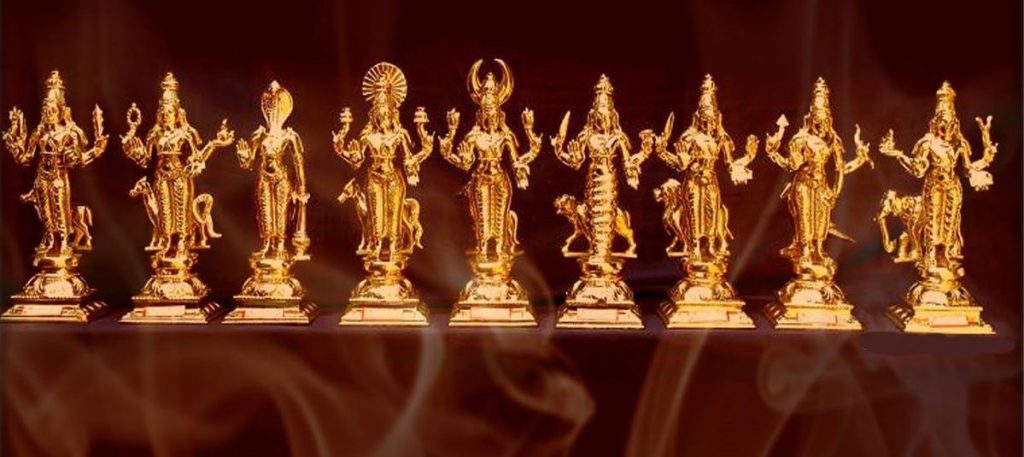
Worship of the Sun, the Moon and other planets, together called as the Navagrahas or the nine celestial bodies, is an important aspect of the Hindu way of life. These deities include the Sun or Surya and the Moon or Chandra along with seven other planetary bodies, namely, Mercury or Budha, Mars or Mangala, Venus or Sukra, Jupiter or Brihaspati/Guru, Saturn or Sani followed by Rahu representing the North Lunar Node and Ketu representing the South Lunar Node. Rahu and Ketu are known as ‘shadow planets’ and are depicted as the head and tail of a demonic snake, respectively. Seven of the nine grahas are linked to the seven days of the week as per the Hindu calendar and are also worshipped individually on these days.
Stories and descriptions about the navagrahas as well as their impact are found throughout our epics such as the Ramayana and the Mahabharata and Puranas including the Brahmanda Purana, the Matsya Purana, the Shiva Purana, the Linga Purana, the Kurma Purana, the Garuda Purana, the Vayu Purana and the Bhavishya Purana.
While Maharishi Valmiki has given a detailed account of the planetary positions at the time of Rama’s birth, Maharishi Vyasa has sketched out the astral landscape leading up to the start of the great Mahabharata war. These details have now proved extremely useful as we seek to ascertain possible dates for the key events of the Ramayana and Mahabharata.
References to planets and deities associated with them are also found in ancient Greek and Roman literature and astrology.
Surya or Sun is central to the solar system, the provider of energy and, therefore, represents life-force, intelligence and prosperity. Chandra or Moon is closely linked to water bodies and influences the mind and emotions. Mangala or Mars is associated with courage and aggression, while Budha or Mercury impacts learning, analytical and communication skills. Guru or Jupiter symbolises wisdom and knowledge and is considered a key catalyst for success, while Sukra or Venus stands for wealth, beauty and desire. Rahu and Ketu are considered powerful points of energy and represent conflicts and ‘karmic’ effects from previous lives.

Sani or Saturn is representative of austerity and discipline, which are important characteristics for leading a spiritual and fruitful life. This graha is often misunderstood and feared to have sweeping negative effects on people. However, under the influence of Sani, one develops a strong sense of responsibility and resilience, the ability to endure and overcome hardships. Sani is also known to shower immense blessings and spiritual strength.
The ‘shadow planets’, Rahu and Ketu, are also believed to have malefic influences during certain hours of the day. For instance, the duration of time wherein Rahu is believed to have negative influence is known as Rahu kaalam. Auspicious ceremonies and important new activities are usually not undertaken during these hours.
The navagrahas are also known to have an impact on the different parts of our bodies and their smooth functioning. For instance, Surya provides longevity and good health, Chandra has an impact on the digestive system, fertility and mental health, Mangala affects muscular strength, Budha causes respiratory and skin-related issues, Guru impacts metabolism, liver and pancreas, Sukra the reproductive organs, while Sani is associated with nerve-related issues and Rahu and Ketu with fears and phobias.
Most temples in South India have, within the temple complex, a place devoted to the navagrahas, where devotees offer prayers and do parikrama or circumambulate the deities, nine times. The navagrahas are usually placed on a black coloured stone or granite pedestal. They are placed in a single square with Surya at the centre surrounded by the other eight deities.
Interestingly, no two navagraha deities are placed facing each other. The directions in which these deities are placed on the pedestal typically based upon whether the temple follows Agama Pratishtha or Vaidika Pratishtha. There are also other kinds of installations and manifestations of the navagraha deities that are found in different temples around the country.
The navagrahas are also represented in the form of navagraha vruksha vanas, which is a cluster of nine different trees that correspond to each of the nine grahas.
Our tradition of worshipping the navagrahas with their different individual positive and negative characteristics and effects, collectively as one unit, is a hallmark of the celebration of multiplicity in our daily lives, in our ecosystems, in our universe.

